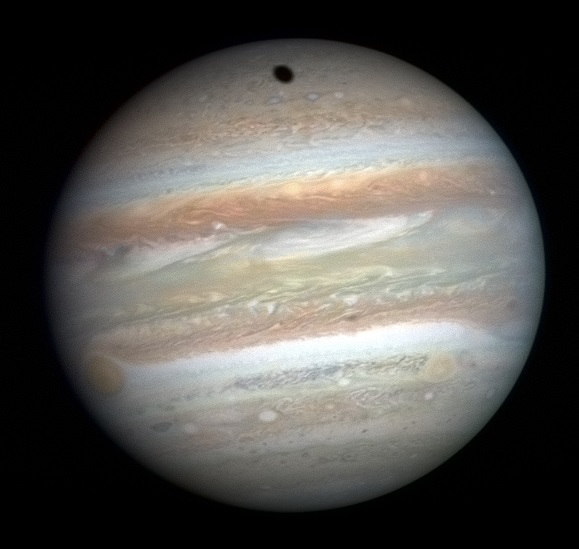Facts for Kids
Jupiter is a massive gas giant and the fifth planet from the Sun, known for its colorful storms and numerous moons.
Overview
Moons Of Jupiter
Rings Of Jupiter
Exploration Missions
Atmosphere And Weather
Comparative Planetology
Jupiter's Magnetic Field
Physical Characteristics
Future Research And Exploration
Orbital And Rotational Dynamics
Jupiter In Culture And Mythology

Inside this Article
The Northern Lights
Greek Mythology
Galileo Galilei
Magnetic Field
Temperature
Atmosphere
Spacecraft
Hydrogen
Future
Orange
Planet
Did you know?
🌌 Jupiter is the fifth planet from the Sun and the largest in the Solar System.
🌍 You could fit over 1,300 Earths inside Jupiter!
🚀 Jupiter has been explored by missions like Pioneer 10, Voyager, and Juno.
💪 It is named after the king of the Roman gods, symbolizing power and strength.
🌪️ The Great Red Spot is a giant storm on Jupiter that has been raging for over 350 years!
🌕 Jupiter has at least 79 moons, including the four Galilean moons: Io, Europa, Ganymede, and Callisto.
🪐 Unlike Saturn, Jupiter has faint rings made up of tiny particles and dust.
🌩️ The temperature in Jupiter's upper atmosphere can drop to as low as -234°F!
💨 Jupiter's storms can have winds up to 400 miles per hour.
🔆 Jupiter has the strongest magnetic field of all the planets in our Solar System!
Introduction
It is the fifth planet from the Sun and is the largest planet in our Solar System. Jupiter is a gas giant, which means it is mostly made up of gases like hydrogen and helium. It’s so big that you could fit more than 1,300 Earths inside it! 🌍
Jupiter is 484 million miles away from Earth and takes about 12 Earth years to complete one orbit around the Sun. It was named after the king of the Roman gods, Jupiter, who was known for his strength and power. 💪
Moons Of Jupiter
Four of these moons are called the Galilean moons: Io, Europa, Ganymede, and Callisto. They were discovered by Galileo Galilei in 1610! 🤓
Ganymede is the largest moon in the Solar System, even bigger than Mercury. Europa is known for its icy surface and may have a hidden ocean. Scientists are very interested in these moons because they could have conditions for life! 🛸
Rings Of Jupiter
Unlike Saturn’s flashy rings, Jupiter's rings are almost invisible and were discovered in 1979 by the Voyager 1 spacecraft. Scientists think the rings are made mostly of ice and rock particles that come from Jupiter’s moons. The rings are very close to the planet and are not as colorful as the other planets' rings. 🌈
They show us that even gas giants like Jupiter can have rings!
Exploration Missions
One of the most exciting missions was Juno, which started studying Jupiter in 2016! Juno is designed to learn more about the planet’s atmosphere, magnetic field, and its moons. It sends us amazing pictures and valuable data about Jupiter. 🖼
️ Each mission has helped scientists understand more about this giant planet and how it works!
Atmosphere And Weather
️ The temperature in the upper atmosphere can drop to -234°F (-145°C)! It also has powerful winds that can reach speeds of up to 400 miles per hour (640 kilometers per hour). 🌬
️ Jupiter's storms can last for a very long time; the Great Red Spot is larger than Earth and has been going strong for centuries. Scientists study Jupiter to learn more about weather patterns in space. 📊
Comparative Planetology
It is the largest planet, and its size influences its gravity and atmosphere. Unlike terrestrial planets like Earth and Mars, which have solid surfaces, Jupiter is mostly gas. ☁
️ It has many more moons than Earth and is very different in temperature and weather patterns. Scientists study these differences in what we call comparative planetology to understand how planets form and evolve in our Solar System. 🌌
Jupiter's Magnetic Field
It's about 20,000 times stronger than Earth's. This giant magnetic field creates incredible auroras, similar to the Northern Lights, at Jupiter's poles. 🌌
The magnetic field is generated by the movement of metallic hydrogen inside the planet. This field protects Jupiter and its moons from harmful space radiation, making it a fascinating place for research about magnetism and its effects in our Solar System! 🔆
Physical Characteristics
Its atmosphere features bands of clouds that include shades of white, yellow, orange, and brown. The Great Red Spot, a huge storm, has been raging for over 350 years! 🌪
️ Jupiter's diameter is about 86,881 miles (139,822 kilometers), making it more than 11 times wider than Earth. Scientists believe Jupiter has a solid core, but it is mostly made of gases. The planet rotates very quickly, completing one spin in just about 10 hours! ⏰
Future Research And Exploration
Future missions, like NASA’s Europa Clipper, are planned to explore Europa's potential for life beneath its icy surface. 🚀
Scientists hope to launch more spacecraft to study Jupiter’s atmosphere, storms, and magnetic field in more detail. 🌠
Each new mission helps us uncover more secrets about this fascinating gas giant! Who knows what amazing discoveries await us in the future? 🌈
Orbital And Rotational Dynamics
It takes about 11.86 Earth years to complete one full orbit! Jupiter spins incredibly fast, which makes day and night shorter there. A day on Jupiter lasts about 9 hours and 55 minutes! ⏱
️ Because of its massive size, the planet has a strong gravitational force, which helps it capture many moons and a lot of debris in space. 🌌
Jupiter In Culture And Mythology
In ancient times, people believed that Jupiter controlled storms and lightning. ⚡
In Greek mythology, he is known as Zeus. The planet has been observed by humans for thousands of years. 🌟
In modern culture, Jupiter appears in many movies, books, and even video games! It is a popular subject for science fiction stories because of its mysterious clouds and powerful storms. 📖

